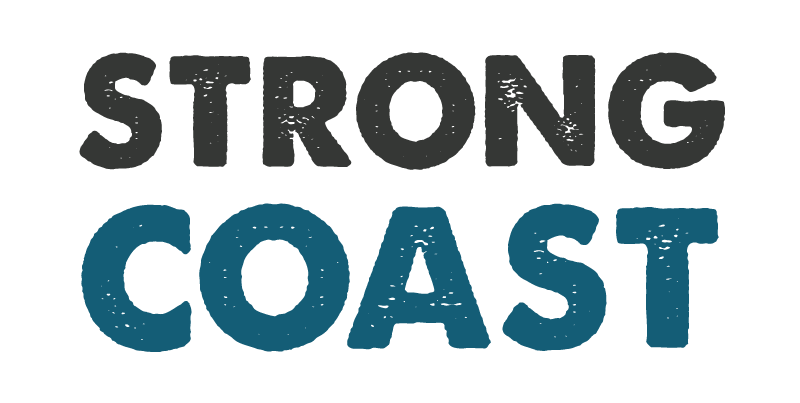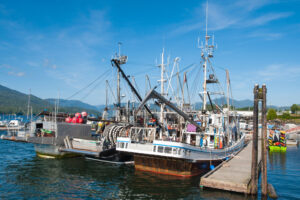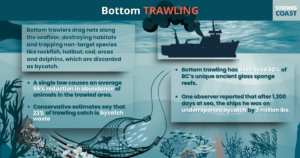Midwater trawling is a technique designed to fish pelagic (midwater) species such as squid and shrimp, and schooling fish like sardines and hake. Boats herd and enclose these target species by towing large nets through the water column above the seafloor. The industry argues this technique is less destructive than dragging nets on the ocean floor, which is one of the major criticisms of bottom trawling. However, is this claim that midwater trawling is less destructive true?
Unravelling the Technique
Midwater trawling nets can be the size of several football fields. They are designed to open wide and scoop up vast quantities of herring, hake, salmon, and other target species. The cone-shaped nets are sectioned, including the mouth (or opening), body, codend (where the catch is collected), and sometimes a trawl door to keep the net open.
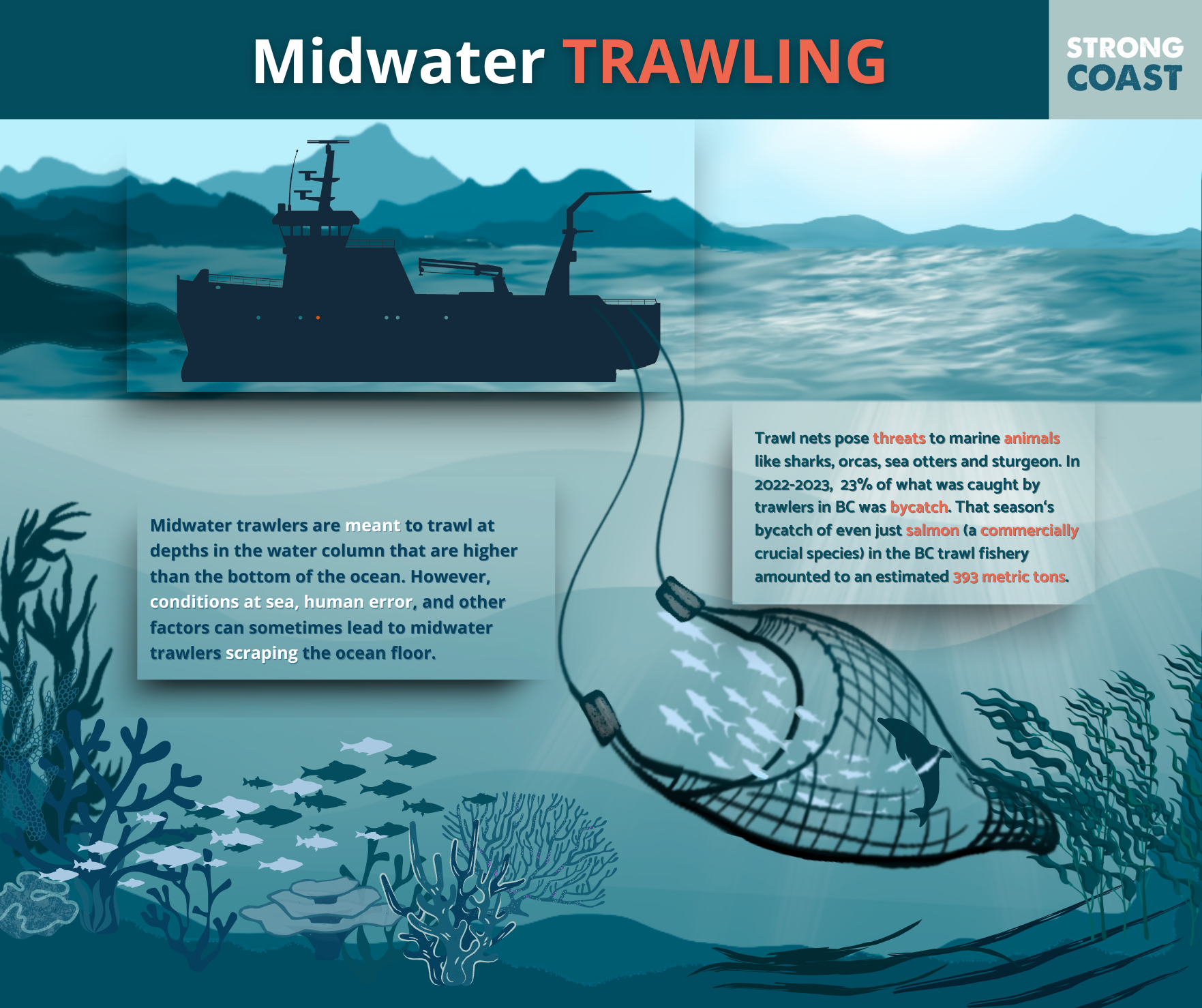
Floats attached to the top of the net and weights attached to the bottom keep it open vertically as the trawler tows it through the water column. Otter boards (also known as trawl doors) spread the net wide as it moves through the water, and the net’s depth can be adjusted, depending on where the target species is most abundant.
The large size of the net and the efficiency of the technique allow midwater trawlers to capture vast volumes of fish in a single haul and catches can weigh several tonnes.
A 2008 report showed that 45% of all commercial fishing in BC was done by midwater trawls, making it the most prevalent fishing practice in the province.
Bycatch in Midwater Trawling
Bycatch refers to the unintentional capture of non-target species while fishing. This can include a variety of marine life such as fish, crustaceans, seabirds, marine mammals, and sea turtles that are not the intended catch. In BC, trawlers are obligated to return bycatch to the water; however, the survival rate of bycatch is extremely low. For instance, the survival rate of salmon and rockfish is virtually zero due to the stresses of capture, including being crushed in the net and being out of the water for too long, and physiology, for instance, being pulled up from the depth causes the swim bladders of rockfish to inflate, which is usually fatal. The capture of these species can have significant ecological, cultural, and economic impacts through the depletion of their populations and disruption of marine ecosystems.
Proponents of midwater trawling say that large holes in nets allow non-target fish to escape and reduce the amount of bycatch. While midwater trawling generally has a lower bycatch rate than the most destructive fishing method, bottom trawling, the nets’ holes do not prevent the bycatch of larger marine animals like seabirds, turtles, sharks, dolphins, and whales. According to Pacific Wild, over 100 different species are victims of midwater trawl bycatch in BC, including smaller marine species such as salmon and eulachon.
Officially, BC’s groundfish trawl, which includes both bottom and mid-water trawling, has a bycatch rate of 23%, which includes protected species, such as yelloweye and bocaccio rockfish. With the average annual trawl catch estimated at 38,500 tonnes in BC, this means that in BC, 8,855 tonnes of fish and other marine species are thrown back into the ocean, either dead or with little chance of survival.
However, an investigative piece by The Narwhal on the BC trawl industry found that a significant amount of bycatch goes unreported. This is because of the fact that once a ship reaches its bycatch limit, it has to shut down for the season. The result of this, according to The Narwhal, is fishery observers facing intimidation by ship captains and crew to underreport. In its investigation, The Narwhal interviewed one observer, who estimated that in his 1,200 or so days at sea as an observer, the ships he was on underreported bycatch by 3 million pounds. This suggests that bycatch waste in BC is much higher than officially reported.
And as a recent monitoring program in BC revealed, the bycatch numbers for culturally, ecologically, and economically important species are far too high. A DFO report released in 2024 revealed that during the 2022/23 groundfish trawl fishery, the Option A midwater trawl, which primarily trawls for hake and flounder, took 28,177 Pacific salmon as bycatch with 26,273 of these salmon being Chinook. Salmon, of course, has been the cultural and economic lifeblood of coastal communities in BC since time immemorial. However, significant declines in salmon populations caused by overfishing, including bycatch, have had a negative effect on the livelihood of many coastal residents. The negative impact that midwater trawling bycatch has on coastal communities is heightened when we consider that the vast majority of this groundfish trawl fishery bycatch came from 7 of the 8 factory freezer trawlers licensed to trawl in BC waters. While these “killing machines” scoop up coastal resources and enrich corporations and foreign entities, coastal communities receive nothing from this harvesting of their resources.
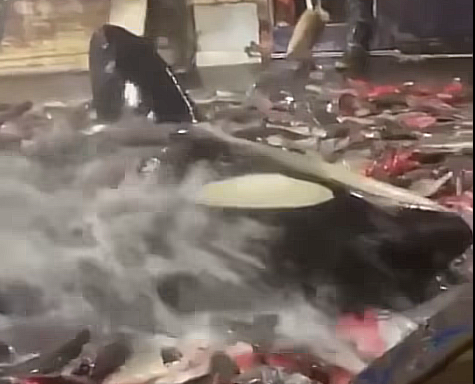
Do Midwater Trawlers Touch the Seafloor?
While midwater trawlers are not designed to touch the seafloor, there is evidence of contact, challenging the claim that this method does not harm benthic (bottom-dwelling) habitats. A North Pacific Fishery Management Council study showed that factory midwater trawlers in the Alaskan pollock fishery can spend up to 100% of their operational time in contact with the ocean bottom, causing physical damage to seabed habitats and negatively affecting bottom-dwelling communities in a way similar to bottom trawling. Because the position of midwater trawl nets can be adjusted to the unpredictable movements of target species, shallow depths, weather events, or human error, contact with the seafloor can happen. Individuals all along the coast are also skeptical of midwater trawling, despite the industry’s claims. A Living Oceans survey of fisherfolk, scientists, fisheries managers, and conservationists gave bottom trawling a severity ranking of 98 out of 100 (based on the ecological impact of the fishing method). Midwater trawling got a score of 52 out of 100 – not great.
A Lack of Oversight
Despite midwater trawling being the most prevalent fishing method on our coast, there is little data about it. The lack of data is a common theme among researchers and managers. On top of that, Canada has a poor record with observers. The DFO requires that certain types of trawlers have observers present to help account for bycatch numbers. However, a 2016 audit of the observer program found that there were no measures in place to “ensure that catch data collected by third-party observers was dependable and timely.” Moreover, as discussed above, onboard observers have revealed that intimitadion from trawler crews results in bycatch being underreported.
The Impact Midwater Trawling Has on the Coastal Food Web and Coastal Communities
Bycatch and trawling directly threaten marine species and have broader ecological and economic consequences. The species overfished by trawlers, as well as species killed as bycatch, help maintain healthy fish stocks and contribute to a sustainable coastal food web. Their loss affects the delicate balance of our coastal ecosystem.
Below are some of the negative impacts that midwater trawling has on coastal communities:
Depletion of Fish Stocks: As discussed above, midwater trawling is known for its high bycatch rates and its ability to significantly deplete fish stocks. Official numbers have the Pacific groundfish trawl with a 23% bycatch rate. This depletion reduces the availability of commercially valuable species, leading to lower catches for local fishers. This is a reality that community fishers in BC are facing, and it has resulted in reduced income for fishing communities that rely on these species for their livelihoods.
Damage to Marine Habitats: Despite industry propaganda claiming otherwise, there is significant evidence that midwater trawl gear contacts the the ocean floor. Therefore, just like bottom trawling, midwater trawling can destroy essential habitats such as coral reefs and seagrass beds. These habitats are crucial for the spawning and development of various marine species. Their destruction can lead to long-term declines in fish populations, further reducing the availability of fish for local fishers and impacting the biodiversity that supports the overall health of marine ecosystems.
Loss of Employment Opportunities: As fish stocks decline due to overfishing and habitat destruction caused by trawling, there are fewer opportunities for employment in the fishing industry, especially in community fisheries. Community-based vessels have crews drawn from coastal communities. Moreover, strong local fisheries enhance local economies through supporting secondary businesses, such as processing and packaging facilities, outfitters, boat building and repair services, as well as restaurants and other service-based businesses. Therefore, the overfishing of trawlers leads to unemployment and economic hardship in coastal communities.
The Case for Marine Protected Areas
The environmental and economic impacts of midwater trawling in BC’s fishing industry are significant. Establishing marine protected areas (MPAs) would help safeguard BC’s marine ecosystems against the impact of this fishing technique.
MPAs are powerful tools. These zones prohibit harmful practices like trawling and give marine species a sanctuary to recover and thrive. Studies show that well-designed MPAs replenish fish populations, restore biodiversity, and even offer benefits to nearby fishing grounds through the spillover effect.
British Columbia’s marine wealth is a treasure worth safeguarding. By working together, we can end destructive practices like midwater trawling and ensure thriving oceans for future generations.
